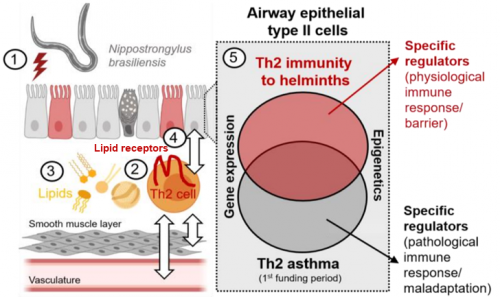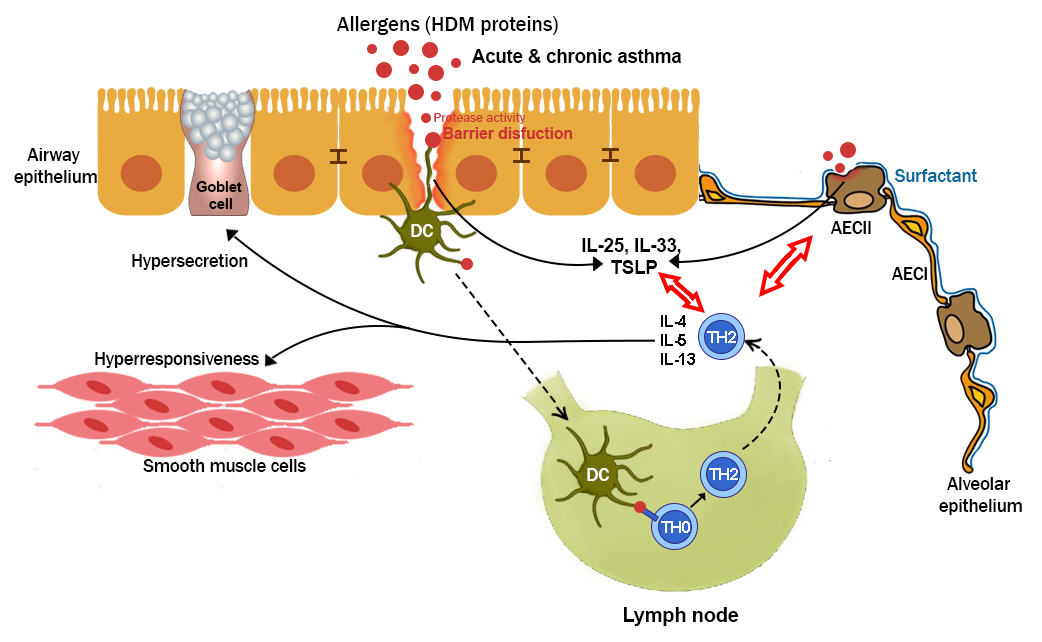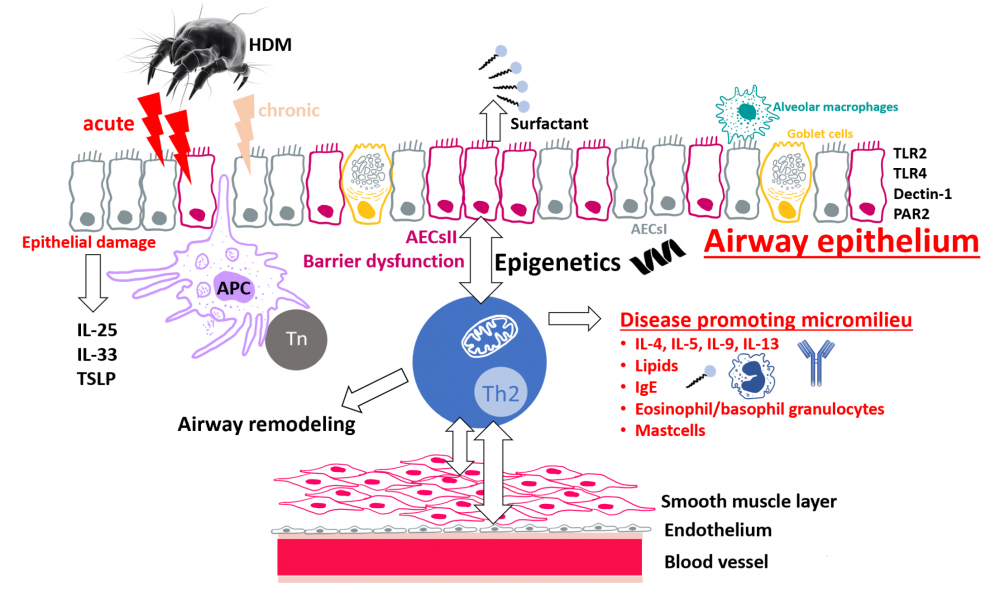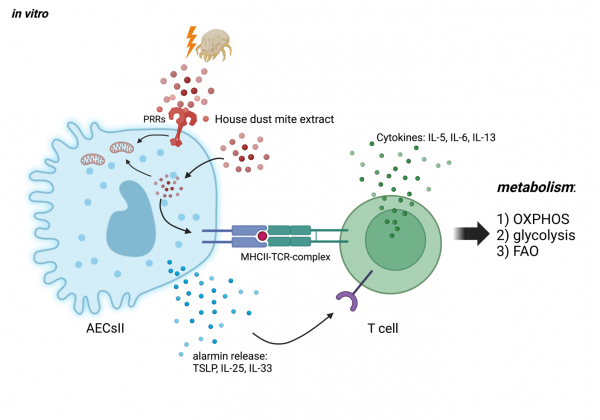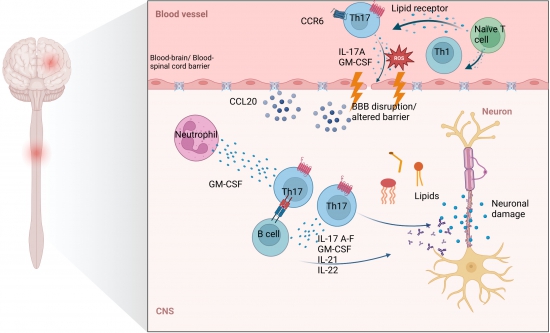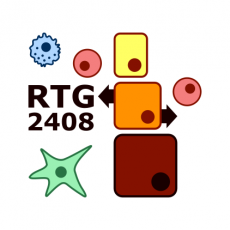Jun.-Prof. Dr. Sascha Kahlfuss
Jun.-Prof. Dr. Sascha Kahlfuss
Project Leader
Project 12
P12-2: Th2 cell-dependent effects on the airway epithelial barrier during chronic asthma
Anna KronePhD Student
Sascha KahlfussProject Leader |
Allergic asthma is characterized by chronic inflammation and airway remodeling, which involves epithelial barrier dysfunction, fibrosis, goblet cell hyperplasia/metaplasia, smooth muscle thickening and increased endothelial permeability. Repetitive chronic exposure to allergens such as from house dust mites (HDM) mediates a dysregulation of the airway epithelia including alveolar type II cells (AECsII). This cumulates in Th2 cell activation and the amplification of asthmatic airway inflammation. However, how the intercellular communication between alveolar epithelial cells and Th2 cells contributes to the fixation of especially chronic asthmatic airway inflammation is not fully understood yet. We hypothesize that in chronic asthma, metabolites provide a specific metabolic environment within the lung, which favors chronic inflammation and fixation of the disease by changing the epithelial barrier. To address this question project 12 will use mice with a conditional deletion of a subclass of lipid receptors in T cells and analyze their potential to develop asthmatic airway inflammation using an acute and a subacute (chronic) HDM lung inflammation model. From these mice, we will isolate T cells and AECsII (cooperation with project 2), analyze their transcriptome by bulk and single cell RNA sequencing (scRNAseq) and study gene regulation by single cell Assay for Transposase-Accessible Chromatin with high-throughput sequencing (scATACseq). Further, we will investigate whether the T cell-specific deletion of certain lipid receptors alters the epithelial barrier integrity during chronic asthmatic airway inflammation (cooperation with Project 4 and Project 8). The ultimate goal of project 12 will be to understand the detailed molecular mechanisms, epigenetic regulation and signaling networks in AECsII (in cooperation with Projekt 1) that are affected by lipid signaling in T cells during the fixation of chronic asthma. |
Photos: by UMMD, Melitta Schubert/Sarah Kossmann
P12-3: Interaction of the airway epithelial barrier and T helper (Th) 2 cells during helminth infection of the lung
Sandra FreierPhD Student
Sascha KahlfussProject Leader |
T helper (Th) 2 cells play a detrimental role in allergic airway inflammation, but also mediate immunity against helminths such as Nippostrongylus (N.) brasiliensis. N. brasiliensis is a gastrointestinal nematode that infects the host at larval stage 3 (L3). Further maturation occurs within the lungs, which results in the onset of respiratory symptoms. During this phase of lung infection, the initial immune system responders emerge. Type 2 innate lymphoid cells (ILC2s) and dendritic cells (DCs) migrate in, and ILC2s release type 2 cytokines such as IL-4, IL-5, IL-9 and IL-13. Following parasite infection, the adaptive immune response is directed towards a T helper (Th) 2 cell response, which is instrumental in recruiting basophils and leads to an isotype class switch to IgE.Th2 cells are therefore one of the key players in the immune response and clearance of parasite infection. In contrast to this protective Th2 immune response, Th2 cells also mediate overshooting immune responses during allergic asthma. In addition, recent studies and our own preliminary data suggest a strong dependence of Th2 cells on lipid metabolism pathways during Th2 asthmatic airway inflammation (Project 12-2). However, yet it is incompletely understood how the interaction between Th2 and airway epithelial cells differs during physiological (immunity to helminths) and pathological (allergic asthma) immune responses. In project 12-3, we will therefore investigate how the lipid receptors regulate Th2 cells and their interaction with the airway epithelium following N. brasiliensis lung infection, with the ultimate goal of comparing the role of lipid metabolism in Th2 cells and their interaction with the airway epithelium during immunity to helminths and allergic asthma. To this end, we will use genetically engineered mice and apply bulk transcriptomics and single cell RNA sequencing. Our project could have significant implications for precision and personalised medicine, for example in the development of novel therapeutics that target pathogenic Th2 cells in allergy without compromising immunity to infection.
Th2 cell-dependent effects on the airway epithelial barrier during chronic asthma and lung helminth infection. 1) Components of N. brasiliensis activate alveolar epithelial type II cells. 2) Primed T cells differentiate into Th2 cells and migrate to the lung. Here, Th2 cells secrete the Th2 cytokines (IL-4, IL-5, and IL-13. 3) Metabolites such as lipids (ox. LDL, free fatty acids) activate lipid receptors in lung Th2 cells. 4) Lipid receptors in Th2 cells is important for the interaction between Th2 cells and the airway epithelia in immunity to helminths (hypothesis). 5) Comparison of gene expression and epigenetic regulation in alveolar type II cells during chronic asthma and lung helminth infection. Abbreviations: Th2 cell, T helper 2 cell. |
Photos: by UMMD, Melitta Schubert/Sarah Kossmann
MD6: Molecular interplay of Th2 cells and the airway epithelium on the transcriptome of alveolar type II cells during asthma
|
|
Allergic asthma is an inflammatory respiratory disease and one of the most common chronic disorders causing alterations of the airway barrier integrity. During the disease pathogenesis, allergens, e.g. from house dust mites (HDMs), evoke a maladaptation of the airway epithelia as HDM components activate receptors on airway epithelial cells (e. g. Dectin-1, TLR2, TLR4, PAR2) and destroy gap junctions between them. Consequently, airway epithelial cells produce specific cytokines including IL-25, IL-33 and thymic stromal lymphopoietin (TSLP). The latter induce an immune response that involves innate but also adaptive immune cells such as T helper (Th)2 cells. We hypothesize that Th2 cells, their metabolic fitness, and their ability to communicate with other immune cells and local structural cells in the lung may play a central role in maladaptive processes of the airway epithelia during chronic asthmatic airway inflammation. Therefore, we here will elucidate the intercellular communication of alveolar epithelial cells and Th2 cells during asthmatic airway inflammation with a special focus on analyzing the transcriptional profile of airway epithelial type II cells (AECsII) during acute and chronic asthmatic airway inflammation.
Intercellular communication between Th2 cells and airway epithelial type II cells during acute and chronic asthmatic airway inflammation. HDM proteases disrupt the airway epithelial barrier. Thereafter, HDM antigens are phagocytosed by dendritic cells (DCs) and subsequently presented in mediastinal lymph nodes to naïve T cells. HDM-primed T cells differentiate into Th2 cells, produce Th2 cytokines (IL-4, IL-5, IL-13) and migrate to the lung, where they promote a disease-amplifying micromilieu. Th2 cell cytokines mediate eosinophil recruitment, airway hyperresponsiveness, and mucus production. During the pathogenesis of allergic asthma, Th2 cells interact with airway epithelial type II cells (AECsII). How this communication affects the transcriptional fixation and maladaptation of AECsII during chronic asthma will be addressed in this project. |
Photos: by UMMD, Melitta Schubert/Sarah Kossmann
MD7: Epigenetic perpetuation of chronic asthma in airway epithelial type II cells
|
|
The development of allergic asthma is associated with specific genetic risk factors, smoking and obesity. Currently, allergic asthma affects approximately 300 million people worldwide, which creates a significant burden to our healthcare system. The disease pathogenesis involves the sensitization and reexposure to environmental allergens such as animal hair, pollen or components of house dust mites (HDM). During chronic asthmatic airway inflammation, the lung microenvironment, which is evoked by the cellular crosstalk of T helper (Th)2 cells and the airway epithelium including airway epithelial type II cells (AECsII), induces a barrier dysregulation, goblet cell metaplasia/hyperplasia, subepithelial fibrosis, increased endothelial permeability and smooth muscle cell thickening. In our project we hypothesize that the specific disease-promoting microenvironment during asthmatic airway inflammation alters the airway epithelial barrier and mediates the perpetuation of chronic lung inflammation by epigenetic mechanisms in AECsII. To experimentally address this question, we induce acute and chronic HDM-induced asthmatic airway inflammation in mice to ultimately study the mechanisms of chronic epigenetic fixation of the disease in AECsII by ATAC sequencing. In addition, we seek to unravel the intracellular signaling pathways in AECsII that are involved during the establishment of chronic allergic lung inflammation. Pathogenesis of HDM-induced asthma. Protease-containing HDM sensitize the airway epithelium via TLR2, TLR4, Dectin-1 and PAR2 and cause epithelial damage. Airway epithelial cells secrete the epithelial-derived factors IL-25, IL-33 and TSLP, so-called alarmins, which initiate type 2 immunity, due to activation of APCs. Naïve T cells differentiate to Th2 cells and migrate to the subepithelial layer. By the production of type 2 cytokines (IL-4, IL-5, IL-9 and IL-13) Th2 cells recruit eosinophils and induce isotype switch and thus IgE production. The disease-promoting milieu cumulates in an epithelial barrier dysfunction and epigenetic fixation of the chronic lung disease. The latter and the intracellular signaling events in airway epithelial cells that are involved in these processes will be investigated in this project. Abbreviations: AECsII, Airway epithelial type II cells; APC, Antigen-presenting cell; HDM, House dust mites; IgE, Immunoglobulin E; IL, Interleukin; PAR, Protease-activated receptor; Th2 cell, T helper 2 cell; TLR, Toll-like receptor; Tn, naïve T cell; TSLP, Thymic stromal lymphopoietin. |
Photos: by UMMD, Melitta Schubert/Sarah Kossmann
MD9: Direct and indirect intercellular communication between alveolar epithelium type 2 cells and T cells during chronic exposure to house dust mite allergens
|
|
During allergic asthmatic airway inflammation, the epithelial barrier is significantly altered, which cumulates in maladaptation, chronic inflammation and the hallmark symptoms of allergic asthma such as shortness of breath, chest tightness and coughing. Sensitization and reexposure to allergens from house dust mites (HDM) cause alveolar epithelial type II cells (AECsII) to lose their barrier integrity and induce the release of soluble mediators, e.g., the alarmins TSLP, IL-33, and IL-25 that activate innate but also adaptive immune cells, including T helper (Th)2 cells. Furthermore, AECsII are able to express MHC-II molecules, which enables them to directly interact with T cell receptors (TCR) on T cells. In this project, we hypothesize that the direct and indirect intercellular communication between AECsII and Th2 cells affect the metabolism and intracellular signaling of both cell types and, thereby, the ability to create a disease promoting micromilieu that favors chronic allergic airway inflammation. Using an in vitro co-culture approach, we elucidate the distinct nature of the disease modifying interaction of AECsII and Th2 cells with the ultimate goal to understand how this contributes to maladaptive processes during allergic airway inflammation.
Interaction of AECsII and Th2 cells during exposure to house dust mite allergens. AECsII can internalize HDM by endocytosis, and present fragments of it via surface expressed MHC-II to TCRs of T cells. As a result, TCR signaling triggers alterations of important metabolic pathways in T cells like oxidative phosphorylation (OXPHOS), glycolysis and fatty acid oxidation (FAO). Furthermore, endotoxins are components of HDM that activate pattern recognition receptors (e. g. TLR4) on the surface of AECsII, which then release alarmins, including TSLP, IL-25 and IL-33 that can directly bind to corresponding receptors. |
Photos: by UMMD, Melitta Schubert/Sarah Kossmann
MD11: Role of lipid receptor signaling in the differentiation and effector function of pathogenic Th17 cells in central nervous system autoimmunity
|
|
Multiple sclerosis (MS) is an autoimmune disease characterized by chronic inflammation, altered blood-brain barrier, demyelination, gliosis and neurodegeneration of the central nervous system (CNS). The pathogenesis of MS involves a complex interplay of genetic, environmental and immunological factors, including dysregulation of Th17 cells. In this project, we will investigate how the lipid metabolism of Th17 cells contributes to their pathogenic potential in mediating experimental autoimmune encephalomyelitis (EAE), an experimental model of MS. By combining metabolic analyses with single cell transcriptomics of spinal cord CD45+ leukocytes, we will elucidate how defective lipid signaling in Th17 cells modifies the blood-brain barrier and the complex interplay of innate and adaptive immune cells during central nervous system autoimmunity.
A central feature in the pathogenesis of multiple sclerosis is the activation of autoreactive T cells peripheral, notably Th17 and Th1 cells, who encounter specific antigens that mimic myelin proteins presented by antigen-presenting cells (APCs). These T cells migrate across the blood-brain barrier (BBB). CCR6 is a chemokine receptor expressed on Th17 cells and important for migration. It binds to CCL20 which is highly upregulated in the CNS during inflammation. The cytokines IL17-A-F, GM-CSF, IL-21, and IL-22 are produced by Th17 cells and are known to contribute to the modulation of tight junctions at the BBB, in example through the induction of oxidative stress in endothelial cells, which leads to increased permeability of the BBB facilitating the invasion of immune cells. In the CNS, autoreactive pathogenic Th17 cells are reactivated by local APCs such as microglia and dendritic cells and initiate an inflammatory response. Th17 cells recruit additional immune cells including CD8+ T cells, B cells, macrophages and neutrophils enhancing the production of other pro-inflammatory cytokines and chemokines and amplifying the inflammatory response, which finally results in neuronal damage. |
Photos: by UMMD, Melitta Schubert/Sarah Kossmann






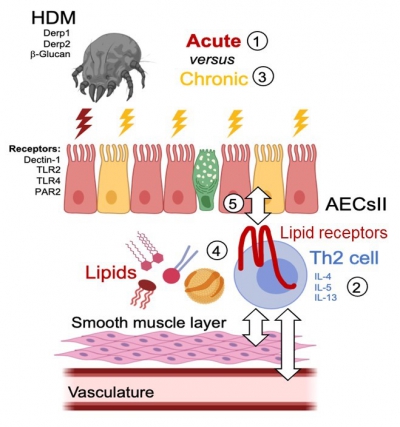 Th2 cell-dependent effects on the airway epithelial barrier during chronic asthma. 1) Components of HDM (Derp1, Derp2, LPS, ß-glucan) acutely activate receptors (Dectin-1, TLR2, TLR4, PAR2) on AECsII. Proteases of HDM destroy gap junctions and antigenic HDM determinants are phagocytosed by DCs and presented in mediastinal lymph nodes to naïve T cells. HDM-primed T cells differentiate into Th2 cells and migrate to the lung. 2) Here, Th2 cells secrete IL-4, IL-5, and IL-13, which mobilize eosinophils to the airways and mediate the production of HDM-specific IgE. 3) Chronic asthmatic airway inflammation through repetitive stimulation with HDM extract. 4) Metabolites such as lipids activate lipid receptors on lung Th2 cells. 5) Lipid receptors on Th2 cells are important for their pathogenic potential in mediating asthma and for the interaction between Th2 cells and the alveolar epithelia during the establishment of chronic inflammation (hypothesis). Abbreviations: HDM, house dust mites; DC, Dendritic cell; Th2 cell, T helper 2 cell; AECII, Alveolar type II cell.
Th2 cell-dependent effects on the airway epithelial barrier during chronic asthma. 1) Components of HDM (Derp1, Derp2, LPS, ß-glucan) acutely activate receptors (Dectin-1, TLR2, TLR4, PAR2) on AECsII. Proteases of HDM destroy gap junctions and antigenic HDM determinants are phagocytosed by DCs and presented in mediastinal lymph nodes to naïve T cells. HDM-primed T cells differentiate into Th2 cells and migrate to the lung. 2) Here, Th2 cells secrete IL-4, IL-5, and IL-13, which mobilize eosinophils to the airways and mediate the production of HDM-specific IgE. 3) Chronic asthmatic airway inflammation through repetitive stimulation with HDM extract. 4) Metabolites such as lipids activate lipid receptors on lung Th2 cells. 5) Lipid receptors on Th2 cells are important for their pathogenic potential in mediating asthma and for the interaction between Th2 cells and the alveolar epithelia during the establishment of chronic inflammation (hypothesis). Abbreviations: HDM, house dust mites; DC, Dendritic cell; Th2 cell, T helper 2 cell; AECII, Alveolar type II cell. 
